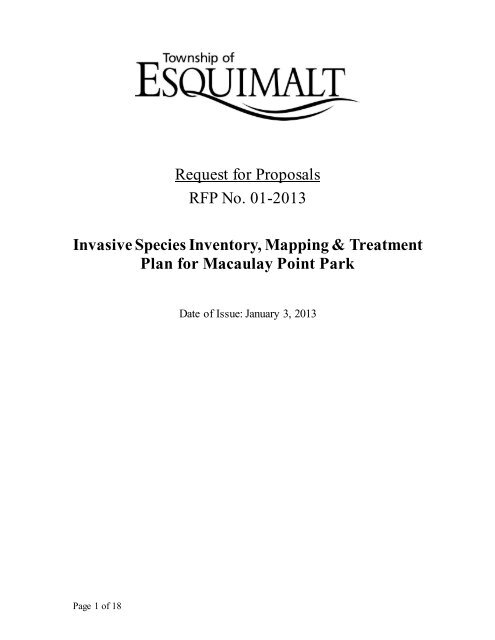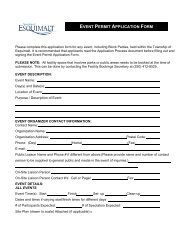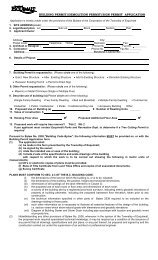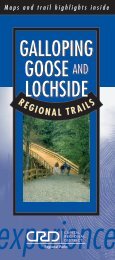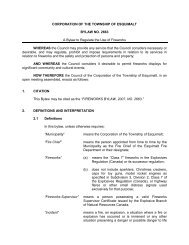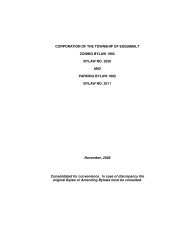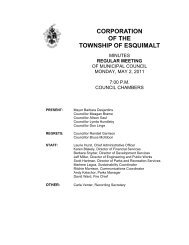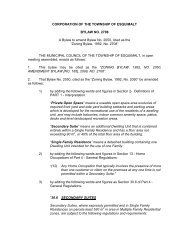Request for Proposals RFP No. 01-2013 Invasive Species Inventory ...
Request for Proposals RFP No. 01-2013 Invasive Species Inventory ...
Request for Proposals RFP No. 01-2013 Invasive Species Inventory ...
You also want an ePaper? Increase the reach of your titles
YUMPU automatically turns print PDFs into web optimized ePapers that Google loves.
<strong>Request</strong> <strong>for</strong> <strong>Proposals</strong><br />
<strong>RFP</strong> <strong>No</strong>. <strong>01</strong>-2<strong>01</strong>3<br />
<strong>Invasive</strong> <strong>Species</strong> <strong>Inventory</strong>, Mapping & Treatment<br />
Plan <strong>for</strong> Macaulay Point Park<br />
Date of Issue: January 3, 2<strong>01</strong>3<br />
Page 1 of 18
TABLE OF CONTENTS<br />
Page<br />
1.0 INTRODUCTION……………….……………………………….3<br />
2.0 PROJECT SCOPE…………………………….…………….…3<br />
3.0 PROPERTY DESCRIPTION …………………………………3<br />
4.0 WORK TO BE DONE…………………………………………..5<br />
5.0 DELIVERABLES………………………..…..…………………..9<br />
6.0 AVAILABLE INFORMATION .……………..…………………10<br />
7.0 MEETINGS…………………..………….……..………………..10<br />
8.0 SCHEDULE …………………………….……..……………… 10<br />
9.0 PROPOSAL ENQUIRIES......................................................10<br />
10.0 PROPOSAL REQUIREMENTS……………..…………………11<br />
11.0 EVALUATION CRITERIA.......................................................12<br />
12.0 GENERAL INSTRUCTIONS FOR THE PROPONENTS.......12<br />
Appendix A<br />
Geospatial Data Requirements<br />
Page 2 of 18
1.0 Introduction<br />
The spread of invasive plant species at Macaulay Point Park has impacted<br />
species at risk and sensitive habitats and has limited recreational use of the site.<br />
The preparation of an <strong>Invasive</strong> <strong>Species</strong> <strong>Inventory</strong> and Treatment Plan is required<br />
<strong>for</strong> managing invasive species and stewardship of the property.<br />
2.0 Project Scope<br />
The long-term goals to be achieved by managing invasive species at Macaulay<br />
Point are:<br />
To protect species at risk (compliance with SARA);<br />
To protect sensitive habitat from further degradation as a result of invasive<br />
species and to restore degraded habitat and;<br />
To maintain or improve recreational opportunities within the Park.<br />
The objectives of this project are:<br />
To determine the location and extent of invasive plant infestations at<br />
Macaulay Point;<br />
To develop maps and spatial databases of invasive plant infestations and<br />
proposed treatment units; and<br />
To develop plans and recommendations on invasive species removal,<br />
vegetation management and site restoration.<br />
3.0 Property Description<br />
Macaulay Point is located in the Township of Esquimalt, within the Capital<br />
Regional District on southern Vancouver Island. The property is a disturbed Garry<br />
Oak ecosystem.<br />
The total project area is approximately 7.5 ha and will include the following areas<br />
identified in Figure 1:<br />
Those portions of Macaulay Point under licence agreement to the<br />
Township of Esquimalt from the Department of National Defence and<br />
excluding the portion on Clifton Terrace (~ 6 ha);<br />
Township of Esquimalt park land including Fleming Beach, Buxton Green<br />
and the breakwater (~ 1.5 ha);<br />
Page 3 of 18
Figure 1. Macaulay Point and the project boundaries.<br />
Scotch Broom (Cytisus scoparius) and Himalayan blackberry (Rubus<br />
armeniacus) occur over much of the property. Daphne (Daphne laureola),<br />
English Ivy (Hedera spp.), English Holly (Ilex aquifolium) and Common Hawthorn<br />
(Crataegus monogyna) are other invasive shrub species that are known on the<br />
property. There are a number of invasive perennial <strong>for</strong>bs on the property as well.<br />
Page 4 of 18
Definitions:<br />
Survey Unit – division of the property into areas to facilitate the invasive<br />
inventory.<br />
Infestation Polygons – grouping of areas infested with a consistent distribution of<br />
one or more species.<br />
Infestation Points – isolated infestations less than 0.2 ha in area.<br />
<strong>Invasive</strong> Plant Treatment Units (Treatment Units) - geographic areas that fulfill<br />
one or more management objective; may include one or more Infestation<br />
Polygons and/or Points.<br />
4.0 Work to be done<br />
I. <strong>Invasive</strong> <strong>Species</strong> <strong>Inventory</strong><br />
An invasive species inventory will be conducted of the Macaulay Point property<br />
(Areas to be included as defined above).<br />
Target species <strong>for</strong> inventory are Scotch broom (Cytisus scoparius), Daphne<br />
(Daphne laureola), Gorse (Ulex europaeus), English ivy (Hedera helix), English<br />
holly (Ilex aquifolium), Common Hawthorn (Crataegus monogyna) and Himalayan<br />
blackberry (Rubus armeniacus).<br />
Other plants that are considered noxious weeds under the BC Weed Control Act<br />
and infestations of other significant invasive plant species (trees, shrubs, herbs or<br />
grasses) encountered should also be recorded and mapped.<br />
The property may be divided into Survey Units to facilitate the survey/mapping<br />
component of this project.<br />
Transects should be used to ensure systematic ground coverage.<br />
<strong>Invasive</strong> plant infestations will be mapped and the characteristics recorded<br />
according to the BC Ministry of Forests, Lands & Natural Resource Operations<br />
<strong>Invasive</strong> Alien Plant Program (IAPP). Provincial guidelines will be used <strong>for</strong><br />
describing invasive species polygons, however data collected <strong>for</strong> this project will<br />
not be entered into the Provincial IAPP on-line site.<br />
Areas infested with a consistent distribution of one or more species will be<br />
grouped into Infestation Polygons and the Infestation Polygon boundaries<br />
mapped. Infestation Polygon size should be chosen to facilitate operational<br />
requirements such as boundaries, layout and treatments. Maximum polygon size<br />
should be 1 hectare. Isolated infestations less than 0.2 ha should be mapped as<br />
points.<br />
The infestations shall be mapped at a minimum scale of 1:1000.<br />
The following characteristics must be recorded <strong>for</strong> each Infestation<br />
Point/Polygon:<br />
<br />
GPS coordinate(s) (see spatial data requirements)<br />
Page 5 of 18
Polygon/Point number/ID<br />
<strong>Invasive</strong> species identified within the point/ polygon<br />
*<strong>Invasive</strong> plant species distribution code (<strong>for</strong> the first through fourth<br />
dominant invasive shrub species)<br />
<strong>Invasive</strong> plant species density code (<strong>for</strong> the first dominant shrub species)<br />
Area of infestation (ha)<br />
Percentage canopy cover of the invasive species<br />
*Distribution codes, ranging from 1 to 9, will be used as classification <strong>for</strong><br />
infestation level. The Infestation Level is the relative infestation level of low,<br />
medium and dense. The distribution codes used to determine the infestation<br />
level are summarized as follows:<br />
1-3 = Light or Low (less than 25% of a 400 m2 plot)<br />
4-6 = Medium (sporadic to well spaced patches)<br />
7-9 = Dense (continuous uni<strong>for</strong>m to dense occurrence)<br />
Maps will be prepared to show the location of the Survey Units and the<br />
Infestation Polygons and Points.<br />
Two spatial data attribute tables will be created, one <strong>for</strong> polygons and one <strong>for</strong><br />
points. Each polygon will be numbered sequentially and each point will be<br />
numbered sequentially with a unique identifier number. The tables will contain the<br />
following (as a minimum):<br />
<strong>Invasive</strong> <strong>Species</strong> Polygon Attribute Table:<br />
Attribute Name Description<br />
Example Value<br />
OBJECTID_1 Unique identifier used by software 2<br />
SUBCLASS Polygon category used by software POLY<br />
SITE Unique site identifier (polygon number/ID) 13<br />
SP1 Primary invasive species (by IP Code) SL<br />
SP1_DIST Primary IP distribution ranking 4<br />
SP1_DENS Primary IP density ranking 2<br />
SP2 Secondary invasive species SB<br />
SP2_DIST Secondary IP distribution ranking 5<br />
SP3 Tertiary invasive species HI<br />
SP3_DIST Tertiary IP distribution ranking 5<br />
SP4 Quaternary invasive species HO<br />
SP4_DIST Quaternary IP distribution ranking 2<br />
COV IP site cover (percent) 40<br />
NOTES Pertinent site in<strong>for</strong>mation HO is at GPS<br />
PT 365<br />
INV_DATE Field survey date Oct 4<br />
Photos Site photo name Oct. 5 pic 13<br />
ECO Dominant ecosystem in the site IMF_BLM<br />
SB_LEVEL Scotch broom infestation level Medium<br />
Page 6 of 18
HI_LEVEL Himalayan blackberry infestation level Medium<br />
EI_LEVEL English ivy infestation level Low<br />
SL_LEVEL Daphne laurel infestation level Medium<br />
HO_LEVEL English holly infestation level Low<br />
AREA Area of site in hectares 1.45<br />
named_site site name (if available) Bivouac 2<br />
point_site Point sites contained in polygon 12, 14<br />
centroid_x Site polygon UTM easting coordinate 463861.59<br />
centroid_y Site polygon UTM northing coordinate 5360087.68<br />
Shape_Leng site perimeter (meters - software use) 522.61<br />
Shape_Area site area (square meters - software use) 14533.62<br />
<strong>Invasive</strong> <strong>Species</strong> Point Attribute Table:<br />
Attribute Name Description Example Value<br />
OBJECTID_1 Unique identifier used by software 2<br />
Site Unique site identifier (point number/ID) 1<br />
GPS_PT GPS waypoint number 4<br />
Eco Dominant ecosystem in the site MF<br />
SP1 Primary invasive species (by IP Code) EI<br />
SP1_Dist Primary IP distribution ranking 7<br />
SP1_Dens Primary IP density ranking 2<br />
SP2 Secondary invasive species HO<br />
SP2_Dist Secondary IP distribution ranking 4<br />
SP3 Tertiary invasive species SL<br />
SP3_Dist Tertiary IP distribution ranking 1<br />
SP4 Quaternary invasive species SB<br />
SP4_Dist Quaternary IP distribution ranking 1<br />
Area Area of site in square meters 100<br />
Photos Site photo name (if available) Oct 4 Pic 13<br />
<strong>No</strong>tes Pertinent site in<strong>for</strong>mation HO has berries<br />
INV_ DATE_ Field survey date Oct 4th<br />
COV IP site cover (percent) 90<br />
Polygon_si Polygon site number point occupies 12<br />
POINT_X Site UTM easting coordinate 463637.42<br />
POINT_Y Site UTM northing coordinate 5360053.09<br />
II. Preparation of an <strong>Invasive</strong> <strong>Species</strong> <strong>Inventory</strong> Report<br />
The <strong>Invasive</strong> <strong>Species</strong> <strong>Inventory</strong> Report will summarize the findings of the<br />
invasive species inventory, outline the methods used to conduct the inventory,<br />
and discuss the findings. It will contain maps, photos, survey field <strong>for</strong>ms, the<br />
polygon and point spatial data and attribute tables, and a description of the<br />
inventory database.<br />
III. Prioritization/Ranking of <strong>Species</strong> and Management Objectives<br />
All invasive species found will be ranked, species to species, using the BC Core<br />
Page 7 of 18
Ranking Criteria. <strong>Species</strong> will be ranked according to their biology, ecology,<br />
species impact and management potential, and then given an overall ranking.<br />
Target species <strong>for</strong> management are Scotch broom (Cytisus scoparius), Daphne<br />
(Daphne laureola), English ivy (Hedera helix), English holly (Ilex aquifolium),<br />
Common Hawthorn (Crataegus monogyna) and Himalayan blackberry (Rubus<br />
armeniacus). Other plants that are considered noxious weeds under the BC<br />
Weed Control Act and infestations of other significant invasive plant species<br />
(trees, shrubs, herbs or grasses) encountered should also prioritized.<br />
The priority management objectives are: reducing invasive plant cover in areas<br />
with known locations of species at risk, and eradicating invasive species that are<br />
not common at Macaulay Point.<br />
IV. Developing <strong>Invasive</strong> Plant Treatment Units<br />
Based on the infestation in<strong>for</strong>mation and recommended treatments, the property<br />
will be divided into a logical number of <strong>Invasive</strong> Plant Treatment Units (Treatment<br />
Units) (geographic areas that fulfill one or more management objectives).<br />
Treatment Units will be based on ecosystem type, invasive species that occur in<br />
the ecosystem and average percent cover of the invasive species.<br />
A Treatment Unit may include one or more polygons of invasive species.<br />
Treatment Unit boundaries shall be selected to facilitate easy layout in the field,<br />
such as roads and trails, streams, fences, openings and stand boundaries.<br />
Maximum Treatment Unit size should be small enough to facilitate treatment<br />
implementation (up to 2 hectares, unless otherwise approved by the Project<br />
Authority).<br />
A map and spatial data of the Treatment Units will be prepared. The map will<br />
show the location of all the <strong>Invasive</strong> Plant Treatment Units with each Unit having<br />
a unique identification number.<br />
Priority sites <strong>for</strong> treatment will be ranked by: the priority ranking of the invasive<br />
plant species, management goal(s)/objective(s), habitat sensitivity and ease of<br />
access <strong>for</strong> treatment.<br />
The spatial data attribute table will contain the following <strong>for</strong> each Treatment Unit<br />
polygon at a minimum:<br />
<strong>Invasive</strong> <strong>Species</strong> Treatment Unit Attribute Table:<br />
Attribute Description<br />
Example<br />
Name<br />
TRMT_UNIT One or more inventory polygons that contain 2<br />
similar percent cover of the same invasive<br />
species. Each TU will have a unique identifier.<br />
Mgmt_Pr Order of importance <strong>for</strong> treatment 1<br />
TU_Infest Average infestation level of treatment unit. Medium<br />
Sites <strong>Inventory</strong> polygon sites 43<br />
Points <strong>Inventory</strong> point sites 19<br />
TR_Limit Factors that may affect Treatment SAR<br />
Page 8 of 18
Attribute Description<br />
Example<br />
Name<br />
ECO_Type Dominant ecosystem in the Treatment Unit Coastal Bluff<br />
Rest_Pre Restoration prescription <strong>for</strong> treatment unit Replace<br />
moss and<br />
lichen<br />
Area_ha Area of treatment unit in hectares 1.45<br />
V. Developing an <strong>Invasive</strong> <strong>Species</strong> Treatment Plan<br />
The Treatment Plan will include:<br />
Discussion of how the Treatment Plan was developed;<br />
Discussion of the priority sites <strong>for</strong> management;<br />
Description of the ranking by invasive species;<br />
General treatment methods and timing <strong>for</strong> each priority species based on<br />
well established practices in invasive plant species control;<br />
Special considerations or limitations to treatment (<strong>Species</strong> at Risk, access,<br />
etc. - a map showing location of all known species at risk will be provided);<br />
Special consideration of existing site-specific established vegetation<br />
management practices including lawn and grass mowing, and flail mowing<br />
of trail edges. These existing practices should be assessed to determine if<br />
they meet best management practices <strong>for</strong> vegetation control methods and<br />
timing;<br />
Recommendations <strong>for</strong> invasive debris biomass removal;<br />
Estimated costs and labour. <strong>No</strong>te that an estimated 30-40 person-days<br />
have been committed annually <strong>for</strong> work in the DND portion of the property<br />
Restoration prescriptions. These prescriptions will be site specific and will<br />
provide recommendations on 1) restoring habitat that was affected by the<br />
presence and/or removal of invasive species and 2) preventing further<br />
invasive species infestations;<br />
A map showing the areas to be treated;<br />
Geodatabase containing spatial data and metadata. Detailed spatial data<br />
requirements are provided in appendix A.<br />
5.0 Deliverables<br />
The deliverables will include the following:<br />
1) The <strong>Invasive</strong> <strong>Species</strong> <strong>Inventory</strong> Report.<br />
2) The <strong>Invasive</strong> <strong>Species</strong> Treatment Plan.<br />
3) Spatial data to support the two reports.<br />
The specific requirements <strong>for</strong> these deliverables are described in the Work to be<br />
Done section.<br />
The deliverables will include:<br />
Three hard copies of the <strong>Invasive</strong> <strong>Species</strong> <strong>Inventory</strong> Report and <strong>Invasive</strong><br />
<strong>Species</strong> Treatment Plan and maps.<br />
Electronic copies of the <strong>Inventory</strong> Report (Word & PDF) and Treatment<br />
Plan (Word & PDF),<br />
Page 9 of 18
Maps in JPG or PDF <strong>for</strong>mat plus ESRI ArcGIS 10.0 MXD<br />
Spatial data (ESRI ArcGIS 10.0 geodatabase <strong>for</strong>mat).<br />
o One project geodatabase containing at a minimum, three feature<br />
classes. These feature classes are: <strong>Invasive</strong> plant inventory<br />
polygons; invasive plant inventory points; invasive plant treatment<br />
units.<br />
o These three feature classes will contain metadata (as per ISO-NAP<br />
standards) and will indicate how polygons and points were created<br />
(GPS and/or digitized), and the accuracy of the spatial data.<br />
o All other feature classes delivered as part of the project<br />
geodatabase will contain, at a minimum, brief metadata to describe<br />
the data and its purpose.<br />
o All spatial data will be in UTM Zone 10, NAD 83 <strong>for</strong>mat.<br />
o All feature classes must have a clean topology (no gaps between<br />
polygons, no overlapping features, etc.).<br />
o Detailed spatial data requirements are provided in Appendix A. All<br />
spatial data must con<strong>for</strong>m to the specification provided in Appendix<br />
A.<br />
6.0 In<strong>for</strong>mation available to the successful contractor<br />
The Macaulay Point Natural Areas Management Plan (Polster 2009)<br />
7.0 Meetings<br />
A pre-work meeting will be held with the successful candidate prior to work being<br />
initiated. The project and expectations will be discussed.<br />
Considerations <strong>for</strong> Working at Macaulay Point<br />
<br />
<br />
<br />
To reduce the risk to some species at risk, a number of sensitive areas<br />
have been declared as <strong>No</strong>-Go Zones. These <strong>No</strong>-Go Zones are fenced<br />
and signed. Access to these areas may be required, and shall be<br />
discussed with DND prior to entry.<br />
Care must also be taken to limit damage to species at risk not contained<br />
within the fenced areas.<br />
Federal or Provincial listed species shall not be removed from the property<br />
<strong>for</strong> sampling purposes.<br />
Qualifications<br />
<br />
<br />
<br />
<br />
<br />
Experience in invasive plant management in coastal British Columbia.<br />
Demonstrated experience with GIS and mapping<br />
Demonstrated experience in invasive plant surveys<br />
Demonstrated experience in preparing operational treatment<br />
plans/prescriptions<br />
Knowledge of ecological restoration<br />
Page 10 of 18
8.0 Schedule<br />
The Proposed schedule <strong>for</strong> this Work is as follows:<br />
<strong>RFP</strong> issued on January 3, 2<strong>01</strong>3<br />
<strong>RFP</strong> closes on January 25, 2<strong>01</strong>3<br />
Final Report due on March 15, 2<strong>01</strong>3<br />
It is the Township’s expectation that work will progress in an organized and timely<br />
manner.<br />
9.0 Proposal Enquiries<br />
All enquires should be written and emailed directly to:<br />
Rick Daykin, Manager of Parks & Facilities Services<br />
Email: Rick.Daykin@esquimalt.ca<br />
10.0 Proposal Requirements<br />
The Proponent shall provide the following in<strong>for</strong>mation:<br />
Title page:<br />
o Reference the <strong>RFP</strong> number and title, the firm’s address, the name<br />
and number of the contact person and the date of the Proposal.<br />
Transmittal Letter:<br />
o A signed letter briefly stating the Proponent’s understanding of the<br />
services required, benefits they bring to the Project, the<br />
commitment to per<strong>for</strong>m the services as requested and confirmed<br />
receipt of all addenda, if applicable.<br />
Table of Contents<br />
Section 1 - Executive Summary<br />
Section 2 - Understanding of the Scope of Work:<br />
o Develop a narrative demonstrating the Proponent’s clear<br />
understanding of the objectives and expected deliverables of the<br />
Work, detail any assumptions the Proponent has made preparing<br />
the Proposal. Include here, any other services not identified in the<br />
Scope of Work.<br />
Section 3 - Work plan and Methodology:<br />
o In<strong>for</strong>mation providing details. The Proposal should be clear and<br />
concise with a methodology and corresponding task list detailing<br />
steps to; fully understand all issues and concerns, and address how<br />
all aspects of the Scope of Work will be carried out.<br />
Section 4 - Schedule:<br />
Page 11 of 18
o Provide a schedule that shows completion of the work.<br />
Section 5 – Proponents and staff qualifications and roles:<br />
o The Proponent shall provide in<strong>for</strong>mation on key individuals that will<br />
be undertaking this Work. This in<strong>for</strong>mation should highlight how the<br />
various individuals will be involved in the Project and their relevant<br />
experience. If a sub-consultant/contract is also to be utilized, this<br />
in<strong>for</strong>mation should also to be supplied.<br />
Section 6 - References:<br />
o Provide a minimum of 3, maximum of 5 reference projects that are<br />
similar in nature. In<strong>for</strong>mation should provide details on past projects<br />
the Proponent has completed that are similar to this project and<br />
demonstrate the Proponent’s suitability. Each reference shall<br />
contain the following:<br />
• Name of the contact person.<br />
• Position of contact person held in the previous project<br />
• Phone number and email address<br />
• Project name/description/cost of project<br />
Section 7 - Quotation:<br />
o Quotation to complete the works.<br />
11.0 Evaluation Criteria<br />
The following criteria outlined below will be utilized in the evaluation of the<br />
<strong>Proposals</strong>.<br />
<br />
<br />
<br />
<br />
<br />
Project Methodology and Task list – 20 points<br />
Experience and Capacity– 20 points<br />
Cost of Project – 30 points<br />
Schedule – 20 points<br />
Past per<strong>for</strong>mance of Proponent– 10 points<br />
12.0 General Instructions<br />
The following instructions, terms and conditions apply to all <strong>Proposals</strong> related to<br />
this <strong>Request</strong> <strong>for</strong> Proposal.<br />
12.1 The Corporation of The Township of Esquimalt expressly reserves rights<br />
to the following:<br />
12.1.1 To accept any Proposal;<br />
12.1.2 To reject any and/or all irregularities in the Proposal submitted;<br />
12.1.3 To reject any and/or all <strong>Proposals</strong>;<br />
12.1.4 To accept a Proposal that is not the lowest cost;<br />
Page 12 of 18
12.1.5 To make decisions with due regard to quality of service and<br />
experience, compliance with requirements and any other such<br />
factors as may be necessary in the circumstances;<br />
12.1.6 To work with any Participant who’s Proposal, in the opinion of the<br />
Management, is in the best interest of The Township.<br />
12.1.7 To cancel or reissue the <strong>RFP</strong>.<br />
12.2 All <strong>Proposals</strong> must be submitted to the Parks and Recreation Services<br />
Department. <strong>Proposals</strong> are to be in one sealed envelope or appropriate<br />
packaging, containing THREE (3) copies, addressed to:<br />
Rick Daykin, Manager of Parks & Facilities Services<br />
Corporation of the Township of Esquimalt<br />
527 Fraser Street<br />
Esquimalt, British Columbia<br />
V9A 6H6<br />
The name and address of the Proponent must appear on the outside of<br />
the packaging, the packaging must display the <strong>Request</strong> <strong>for</strong> Proposal title,<br />
due date and time.<br />
Due Date and Time<br />
January 25, 2<strong>01</strong>3 2:00 PM local time<br />
12.3 A Proposal will not be considered if it is deemed to be incomplete in any<br />
fashion or unsigned by the appropriate authority.<br />
12.4 Any Proposal received after the hour and date specified will not be<br />
considered and will be returned unopened.<br />
12.5 Telephoned, e-mailed and faxed <strong>Proposals</strong> will not be accepted.<br />
12.6 Modification of a Proposal after <strong>RFP</strong> closing date will result in the return of<br />
the Proposal.<br />
12.7 Any contract that may be entered into as a result of this Proposal will be<br />
subject to the laws of the Province of British Columbia.<br />
12.8 It is the responsibility of the Proponent to thoroughly examine these<br />
documents and satisfy itself as to the full requirements of this <strong>RFP</strong>.<br />
Page 13 of 18
12.9 While The Township has used considerable ef<strong>for</strong>t to ensure an<br />
accurate representation of in<strong>for</strong>mation in this <strong>RFP</strong>, the in<strong>for</strong>mation contained<br />
herein is supplied solely as a guideline <strong>for</strong> Proponents. The in<strong>for</strong>mation is not<br />
guaranteed to be accurate, nor is it necessarily comprehensive or exhaustive.<br />
The Township will assume no responsibility <strong>for</strong> any oral in<strong>for</strong>mation or<br />
suggestion(s).<br />
12.10 Proponents are solely responsible <strong>for</strong> their own expenses in preparing<br />
a response and <strong>for</strong> subsequent negotiations, if any. If The Township elects to<br />
reject all responses, The Township will not be liable to any Proponent <strong>for</strong> any<br />
claims, whether <strong>for</strong> costs or damages incurred by the Proponent in preparing the<br />
response, loss of any anticipated profit in connection with any final contract, or<br />
any other matter whatsoever.<br />
12.11 All documents, reports, proposal submissions, working papers or other<br />
materials submitted to The Township shall become the sole and exclusive<br />
property of The Township and as such, are subject to Freedom of In<strong>for</strong>mation<br />
Legislation. To request documentation confidentiality, proponents must submit a<br />
covering letter, with their proposal, detailing the specifics of their request.<br />
12.12 Except as expressly and specifically permitted in these General<br />
Instructions to Proponents, no Proponent shall have any claim <strong>for</strong> any<br />
compensation of any kind whatsoever, as a result of participating in the <strong>RFP</strong>, and<br />
by submitting a proposal each Proponent shall be deemed to have agreed that it<br />
has no claim.<br />
12.13 The Proponent warrants that the Proponent is not employed by The<br />
Township, nor is an immediate relative of such an employee, if the goods or<br />
services to be supplied under this Proposal are intended to be supplied to the<br />
department in which such employee works.<br />
12.14 If the Proponent is a company, the Proponent warrants that none of its<br />
officers, directors or employees with authority to bind the company is an<br />
immediate relative of employees of The Township, if the goods or services to be<br />
supplied under this proposal are intended to be supplied to the department in<br />
which such employee works.<br />
Page 14 of 18
12.15 In this section “Immediate Relative” means a spouse, parent, child,<br />
brother, sister, brother-in-law, or sister-in-law or a municipal employee.<br />
12.16 If any director, officer, employee, agent or other representative of a<br />
Proponent makes any representation or solicitation to any Mayor, Councillor,<br />
officer or employee of The Township with respect to the Proposal, whether be<strong>for</strong>e<br />
or after the submission of the Proposal, The Township shall be entitled to reject<br />
or not accept the Proposal.<br />
12.17 The key personnel named in the Proponents <strong>RFP</strong> response, shall<br />
remain in these key positions throughout the project. In the event that key<br />
personnel leave the firm, or <strong>for</strong> any unknown reason are unable to continue<br />
fulfilling their role, the Proponent must propose a suitable replacement, and<br />
obtain written consent from The Township. Acceptance of the proposed<br />
replacement is at the sole discretion of The Township.<br />
12.18 Any and all addendums to this <strong>RFP</strong> opportunity will be <strong>for</strong>warded to all<br />
prospective Proponents. It is the sole responsibility of participants to ensure<br />
they have provided accurate contact in<strong>for</strong>mation to receive all addendums prior<br />
to <strong>RFP</strong> closing.<br />
12.19 Proponents responding to this competitive process agree to the terms<br />
and conditions of the Proposal opportunity as issued by The Township.<br />
Submissions shall not contain any alterations to the posted document other then<br />
entering data in the spaces provided or including attachments as necessary.<br />
Participants who alter the document as issued may be disqualified from this<br />
competition.<br />
12.20 The Proponent shall indemnify and save harmless The Township and<br />
its officials, officers, employees and agents from any claim, lawsuit, liability, debt,<br />
demand, loss or judgment (including costs, defence expense and interest)<br />
whatsoever and howsoever arising either directly or indirectly as a result of the<br />
granting of this contract or the use of The Township’s property or facilities.<br />
12.21 The Proponent shall waive all rights or subrogation or recourse against<br />
The Township as a result of the granting of this contract or the use of The<br />
Township’s property or facilities.<br />
Page 15 of 18
12.22 The Proponent shall indemnify and pay The Township promptly, on<br />
demand <strong>for</strong> any loss or damage to The Township’s property and facilities arising<br />
either directly or indirectly as a result of the use of the property or facilities under<br />
the terms of this contract.<br />
12.23 The successful proponent must possess an inter-municipal or nonresident<br />
business licence and will be required to provide evidence of same.<br />
12.24 The Proponent must be registered and remain in good standing,<br />
throughout the terms of this contract with the WorkSafe BC and will be required<br />
to provide evidence of same.<br />
12.25 INSURANCE<br />
The Proponent shall, at their own expense, provide and maintain until the<br />
completion of the Project the following insurance in a <strong>for</strong>m acceptable to The<br />
Township with an insurer licensed in British Columbia:<br />
12.25.1.1 Comprehensive General Liability Insurance<br />
$2,000,000.00<br />
12.25.1.2 Professional Liability<br />
$1,000,000.00<br />
The Proponent shall provide and maintain Comprehensive General Liability<br />
Insurance with a minimum limit of $2,000,000 and Professional Liability with a<br />
minimum limit of $1,000,000 inclusive per occurrence, <strong>for</strong> bodily injury, death and<br />
property damage.<br />
Such policy shall include:<br />
The Township and its officers, employees, officials, agents, representatives and<br />
volunteers as Additional Insured<br />
Cross liability and a waiver of subrogation or recourse against The Township<br />
Thirty (30) days prior written notice of cancellation or reduction in coverage in<br />
favour of The Township, to be delivered by registered mail to the attention of the<br />
Risk Manager at the address of Municipal Hall.<br />
The Proponent shall be responsible <strong>for</strong> any deductibles or reimbursement<br />
clauses within the policy.<br />
The Proponent shall provide The Township with a Certificate of Insurance prior to<br />
the commencement of the Proponent programs and within two weeks of the<br />
Page 16 of 18
expiry date of the policy to evidence renewal of the policy and continuous<br />
coverage.<br />
The Township shall be under no obligation to verify that the coverage<br />
outlined in Clause 12.25.2 is adequate <strong>for</strong> the needs of the Proponent.<br />
12.26 All <strong>Proposals</strong> shall be irrevocable to remain open <strong>for</strong> acceptance <strong>for</strong> at<br />
least (60) sixty days after closing time, whether or not another Proposal has been<br />
accepted.<br />
12.27 BEST OFFER<br />
12.27.1 The Township will notify the successful Proponent that its Proposal has<br />
been selected as the Best Offer.<br />
12.27.2 A contract is <strong>for</strong>med only when the owner issues a purchase order to<br />
the selected Proponent who has submitted the Best Offer.<br />
Page 17 of 18
Appendix A<br />
Geospatial Data Requirements<br />
Data Collection.<br />
There are a number of approaches to capturing digital data that can be<br />
employed, including digitizing features from maps or aerial photographs, and<br />
differential Global Positioning System (dGPS) collection. When digitizing features<br />
from maps or photographs, the source, scale, date and methods should be<br />
recorded in the Metadata. When using dGPS collection, the dGPS unit type,<br />
averaging method, post processing and other criteria should be recorded in the<br />
Metadata. dGPS collection methods should follow the BC Standards,<br />
Specification and Guidelines <strong>for</strong> Resource Surveys Using Global Positioning<br />
System (GPS) Technology - Release 4.0. The required horizontal and vertical<br />
position accuracy is 1 metre or better at the 95% confidence level <strong>for</strong> each (the<br />
level of accuracy should be discussed with the DND Project Manager prior to<br />
data collection to ascertain the project specific requirements).<br />
All spatial data shall be geo-referenced and provided in the following standard<br />
projection:<br />
a. Projection: Universal Transverse Mercator<br />
b. Datum: <strong>No</strong>rth American Datum 1983<br />
c. Spheroid: GRS 1980<br />
d. False Easting: 500,000<br />
e. False <strong>No</strong>rthing: 0<br />
f. Units: Meters<br />
The vertical position component (Z) shall be the orthometric height referenced to<br />
the Canadian Geodetic Vertical Datum of 1928 (CGVD28) with the height<br />
expressed in metres.<br />
Data Submission<br />
1. All geographic data generated in the course of a project shall be delivered as<br />
an ArcGIS 10.0 file geodatabase.<br />
2. All geospatial data must be accompanied with associated metadata in<br />
accordance with the <strong>No</strong>rth American Profile (NAP) of International Standard on<br />
Geographic In<strong>for</strong>mation. Canadian General Standards CAN/CGSB-171.100-2009<br />
- <strong>No</strong>rth American Profile of ISO 19115: 2003 Geographic In<strong>for</strong>mation - Metadata<br />
(NAP - Metadata). <strong>No</strong>te the following exception to con<strong>for</strong>mance with this<br />
standard:<br />
- ArcCatalog should be utilized to create and manage metadata. As this<br />
application does not currently meet the standard requirements, metadata should<br />
be created in accordance with NAP - Metadata whenever possible within the<br />
software constraints.<br />
Page 18 of 18


